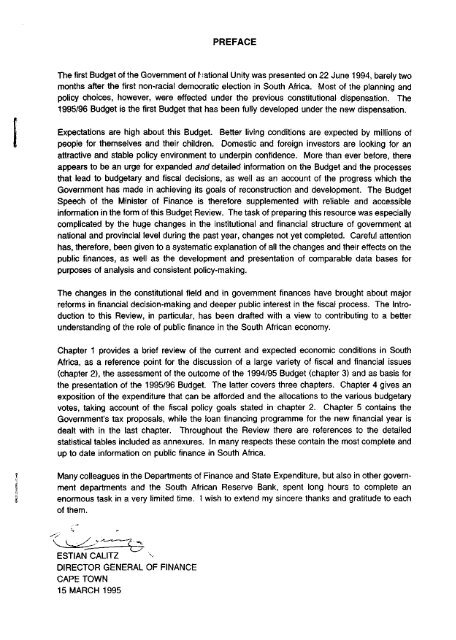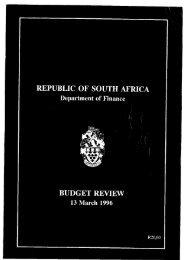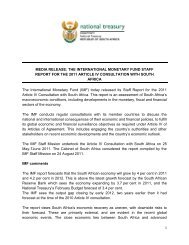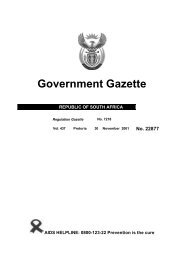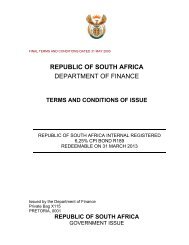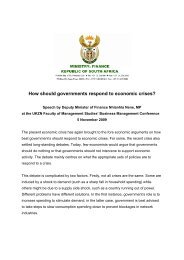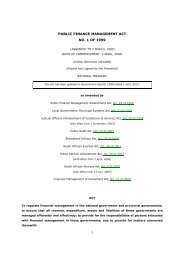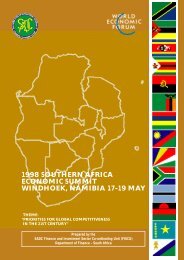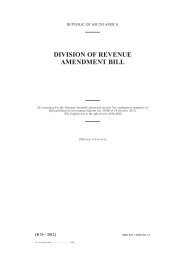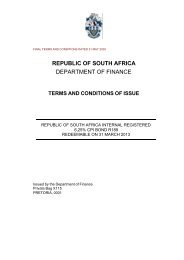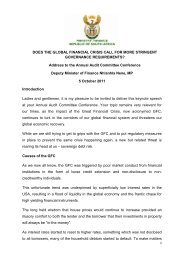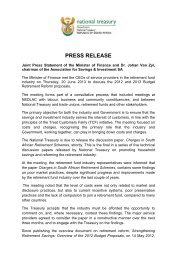1995 - National Treasury
1995 - National Treasury
1995 - National Treasury
Create successful ePaper yourself
Turn your PDF publications into a flip-book with our unique Google optimized e-Paper software.
PREFACE<br />
The first Budget of the Government of f lational Unity was presented on 22 June 1994, barely two<br />
months after the first non-racial democratic election in South Africa. Most of the planning and<br />
policy choices, however, were effected under the previous constitutional dispensation. The<br />
<strong>1995</strong>/96 Budget is the first Budget that has been fully developed under the new dispensation.<br />
Expectations are high about this Budget. Better living conditions are expected by millions of<br />
people for themselves and their children. Domestic and foreign investors are looking for an<br />
attractive and stable policy environment to underpin confidence. More than ever before, there<br />
appears to be an urge for expanded and detailed information on the Budget and the processes<br />
that lead to budgetary and fiscal decisions, as well as an account of the progress which the<br />
Government has made in achieving its goals of reconstruction and development. The Budget<br />
Speech of the Minister of Finance is therefore supplemented with reliable and accessible<br />
information in the form of this Budget Review. The task of preparing this resource was especially<br />
complicated by the huge changes in the institutional and financial structure of government at<br />
national and provincial level during the past year, changes not yet completed. Careful attention<br />
has, therefore, been given to a systematic explanation of all the changes and their effects on the<br />
public finances, as well as the development and presentation of comparable data bases for<br />
purposes of analysis and consistent policy-making.<br />
The changes in the constitutional field and in government finances have brought about major<br />
reforms in financial decision-making and deeper public interest in the fiscal process. The Introduction<br />
to this Review, in particular, has been drafted with a view to contributing to a better<br />
understanding of the role of public finance in the South African economy.<br />
Chapter 1 provides a brief review of the current and expected economic conditions in South<br />
Africa, as a reference point for the discussion of a large variety of fiscal and financial issues<br />
(chapter 2), the assessment of the outcome of the 1994/95 Budget (chapter 3) and as basis for<br />
the presentation of the <strong>1995</strong>/96 Budget. The latter covers three chapters. Chapter 4 gives an<br />
exposition of the expenditure that can be afforded and the allocations to the various budgetary<br />
votes, taking account of the fiscal policy goals stated in chapter 2. Chapter 5 contains the<br />
Government's tax proposals, while the loan financing programme for the new financial year is<br />
dealt with in the last chapter. Throughout the Review there are references to the detailed<br />
statistical tables included as annexures. In many respects these contain the most complete and<br />
up to date information on public finance in South Africa.<br />
Many colleagues in the Departments of Finance and State Expenditure, but also in other government<br />
departments and the South African Reserve Bank, spent long hours to complete an<br />
enormous task in a very limited time. I wish to extend my sincere thanks and gratitude to each<br />
of them.<br />
ESTIAN CALITZ \<br />
DIRECTOR GENERAL OF FINANCE<br />
CAPE TOWN<br />
15 MARCH <strong>1995</strong>


